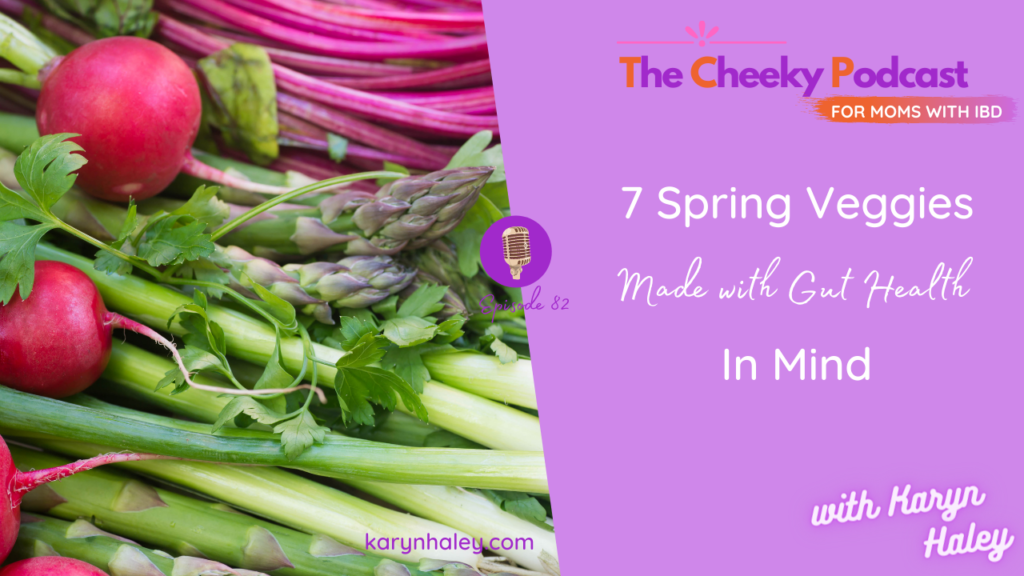
7 Gut Friendly Spring Veggies and How to Prepare Them for Optimal Gut Healing
Podcast: Play in new window | Download
Do you eat seasonally or do you just buy whatever you see at your grocery store?
Heaven knows that pretty much everything we want is at our fingertips, year-round in American grocery stores. But the truth is, we can get so much more flavor and so many more nutrients out of our produce if we buy it when it’s just been picked, when it’s ripe, and in season.
Today, I’m sharing with you the top 7 seasonal veggies you’ll want to stock up on this spring and then we’ll get into my favorite part, how you can prepare each of these veggies no matter where you’re at on your gut healing journey.
It’s all about making them in a way that supports your body’s digestion and absorption, at whatever stage it’s at right now.
It’s a spring veggie extravaganza and yes, I just get that excited over spring vegetables.
Three Things You’ll Learn in This Episode
- How to prepare spring vegetables for wherever you’re at in your IBD healing journey
- The reason why some of these veggies may not have appealed to you before (and how to make them so they taste amazing)
- Why and how to store your veggies properly for better nutrition and better taste
Rate, Review and Subscribe on Apple Podcasts
Mentioned in This Episode:
Want to Get Cookin’ With the 7 Best Gut Healthy Spring Vegetables?
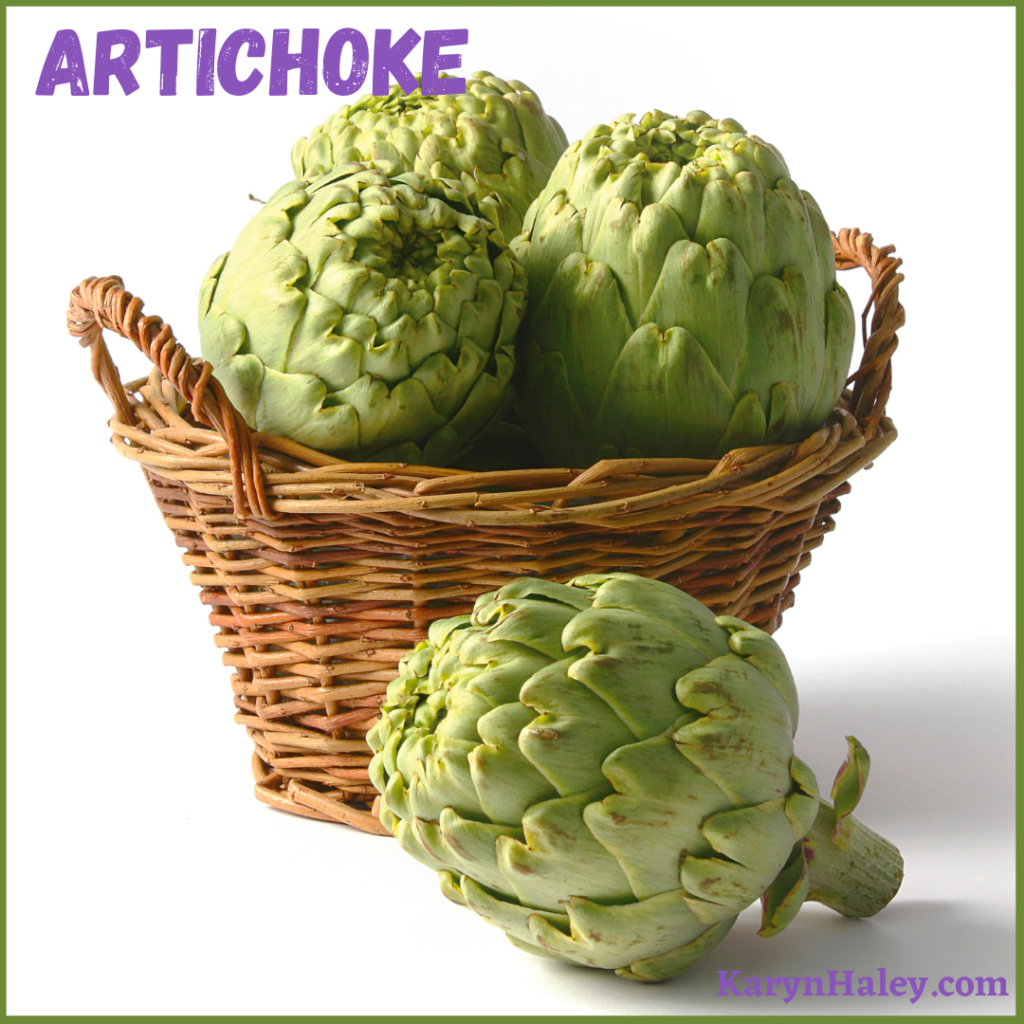
How to Cook and Eat an Artichoke
Chicken Spinach and Artichoke Dip
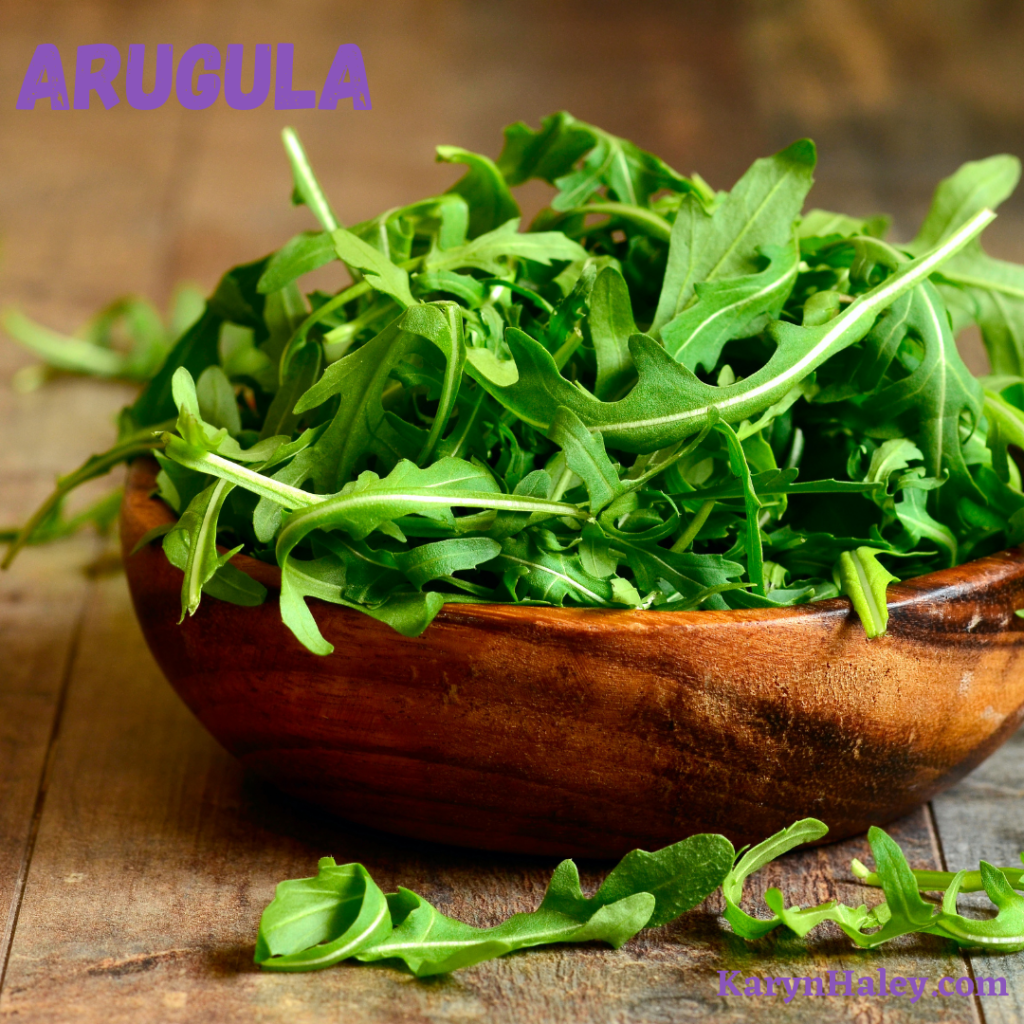
Arugula Smoothie with Pineapple and Mango
Arugula Salad with Lemon Balsamic Vinaigrette
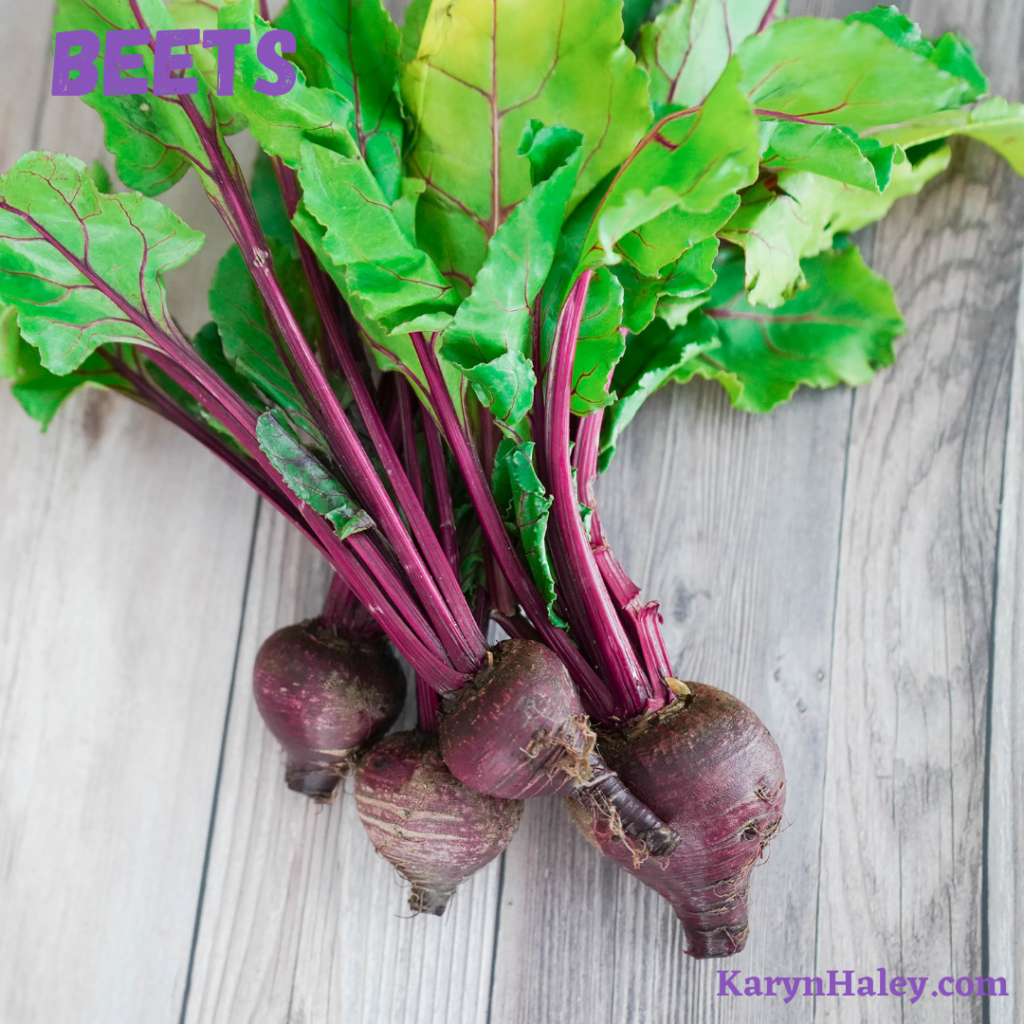
Five Spice Beet Noodles with Fresh Herbs
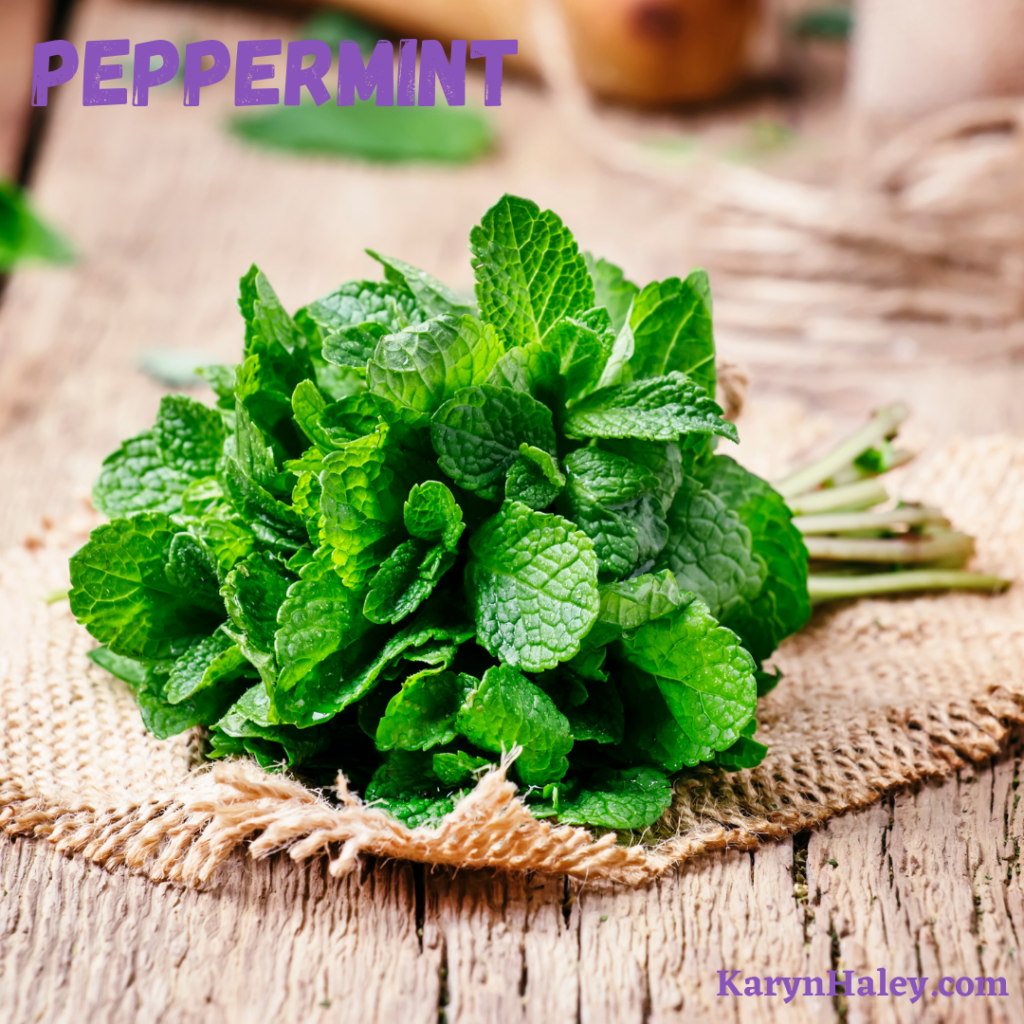
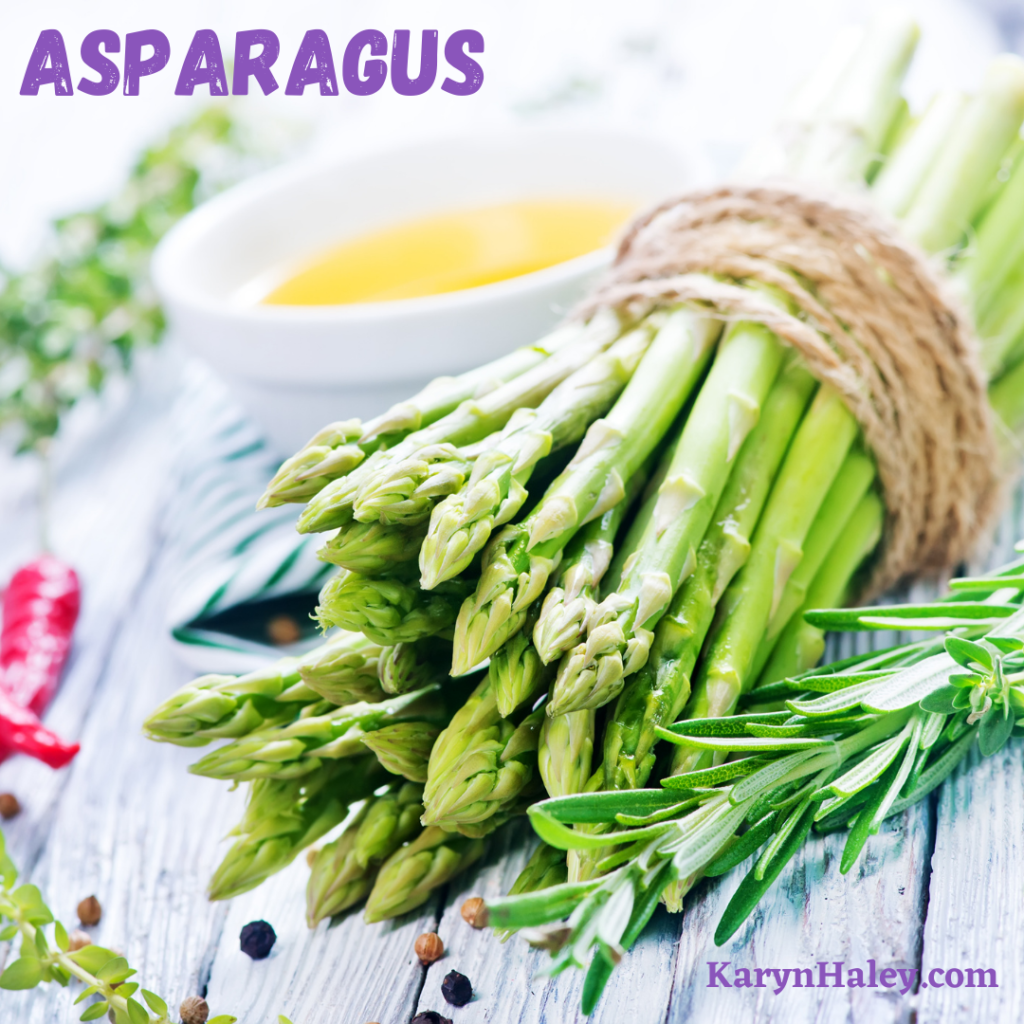
Quick and Easy Blanched Asparagus

Spring Peas Nutrition Benefits
Sweet Pea Strawberry Banana Smoothie
Gluten Free Asian Spring Pea and Asparagus Salad
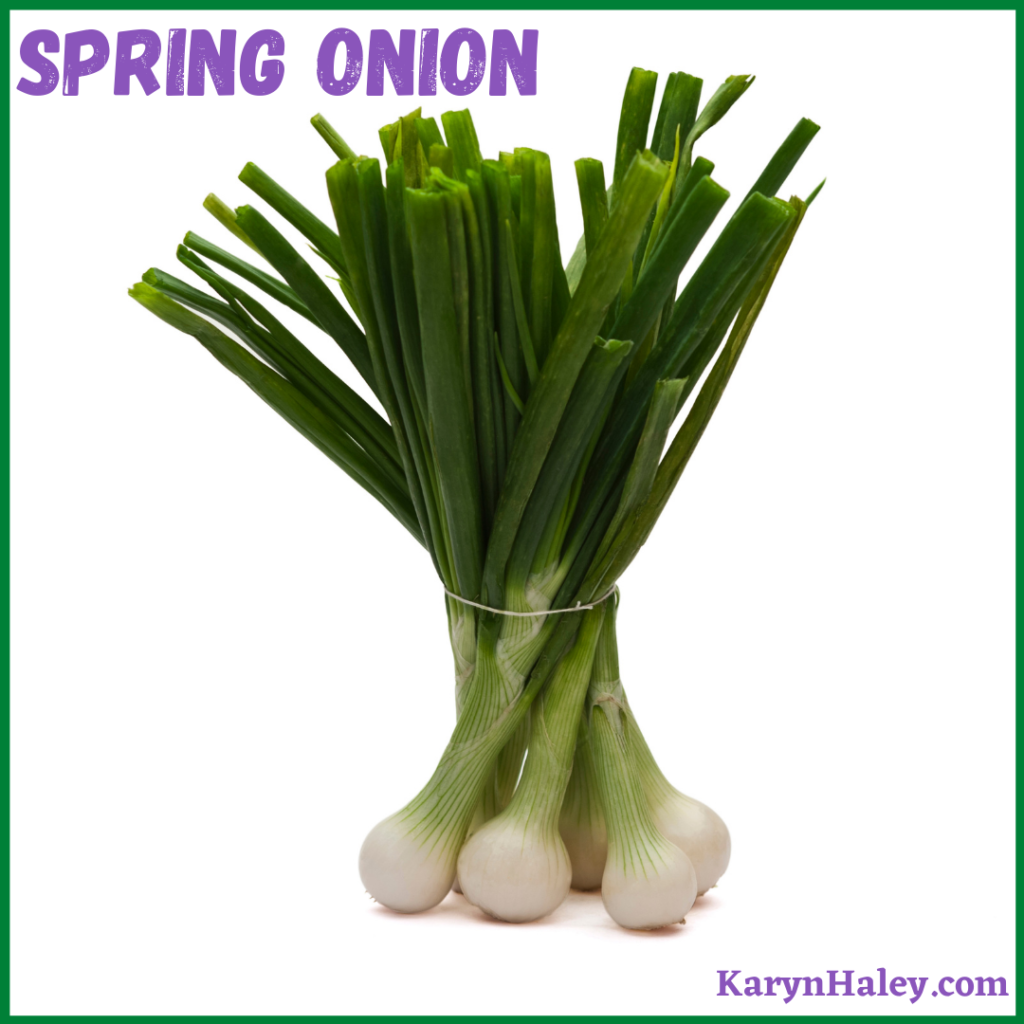
Spring Onions Nutrition Benefits
Chinese Chicken Salad with Spring Onions
Connect With Karyn:
Schedule Your FREE 30-Minute IBD Consult
Episode Transcript:
Do you eat seasonally or do you just buy whatever you see at your grocery store? Heaven knows that pretty much everything we want is at our fingertips, year-round in American grocery stores. But the truth is, we can get so much more flavor and so many more nutrients out of our produce if we buy it when it’s just been picked, when it’s ripe, and in season.
Today, I’m sharing with you the top 7 seasonal veggies you’ll want to stock up on this spring and then we’ll get into my favorite part, how you can prepare each of these veggies no matter where you’re at on your gut healing journey. It’s all about making them in a way that supports your body’s digestion and absorption, at whatever stage it’s at right now. It’s a spring veggie extravaganza and yes, I just get that excited over spring vegetables. Here we go!
[MUSIC]Hey there dear one. Karyn with you on another episode of The Cheeky Podcast. Spring is in the air. Can you feel it? A little late in my opinion. I was ready about a month ago, but I’m happy it seems to finally be settling in. Have you noticed more people out and about, with a little more energy and a little spring in their step, a little giddy maybe. There’s just something about spring that brings out a reawakening in us. It’s like we’re mirroring the grass getting greener, the trees growing leaves again and the flowers blooming.
Yep, I have to say that there’s an energy out there associated with each season and that’s why one of my favorite seasons is spring. Something I’ve learned about myself is that I’m really a creature of whatever season I’m in. Winter always makes me want to curl up in a warm blanket, start a fire, and hang out at home with a good book or watching a movie. But when spring comes, I feel this pull to get out, get moving again, doing things that energize me. Does any of that fit for you too?
For lots of people in the world, coming out to enjoy the energy of spring means it’s time to move from cozy, warming soups and stews to fresh, crisp veggies and big raw salads. But many of us with Crohn’s and colitis need a gentler approach for our food choices. Raw veggies and salads galore may not be on our spring table. So the question becomes, how can we embrace all the fun, healthy, delicious veggies spring as to offer in a way that supports our sensitive digestive tract and our IBD healing?
That’s our focus for today. Eating seasonally with all of nature’s and spring’s best produce, but eating it in a way that works for where we’re at with our gut health.
So that we’re both starting this conversation in the same place, I want you to know that I’m a huge advocate for eating seasonally—especially when it comes to produce. In America at least, our grocery stores are full of cantaloupes and strawberries in January even though they are at their peak much later in the year and fall squashes like butternut and acorn are available year-round. But if you want to get the best nutrients from the food you eat, if you want all those vitamins and minerals to benefit your gut. We’ve got to eat them when they are recently picked, ripe, full of nutrients and full of flavor.
Eating seasonally for spring means that some of my absolute favorite veggies are at their peak and it’s time to buy them at the grocery store, the farmer’s market, maybe even grow them in your garden.
Today, I’ve got 7 of the best spring veggies to share with you. I’ll tell you why they will benefit you to eat them in the spring, share with you how to prepare them for where you’re at on your gut healing journey and tell you how you can get your hands on multiple recipes with these veggies as their star ingredient to help you get started eating them as early as right after this episode.
Let’s start with one of my favorite spring veggies #1: artichokes.
Artichokes, some love them, some hate them. But I have to say that I think those who don’t care for them just haven’t found the proper way to prepare them. Because when they are prepared right and when you eat them in season, artichokes are delicious.
Nutritionally, artichokes are full of the B vitamin folate (great for you mama if you are pregnant or thinking about getting pregnant. Artichokes are also full of vitamin C and other B vitamins as well as potassium and iron. Plus, they’re actually a good source of protein. Not many veggies can boast that.
If you’re struggling with your gut health, lots of inflammation, bacterial imbalance, you’ll want to eat your artichokes boiled or steamed so they are more on the cooked side. You can then dip the leaves in EVOO (extra virgin olive oil) which is really all they need to taste divine. You can also eat artichokes as part of an artichoke dip or even purred in a soup. If you’re Crohn’s or colitis is kind of middle of the road, you’re not in a full blown flare but you’re not in complete remission either, you can soften your artichoke and make it more digestible by grilling it. Have you ever had grilled artichokes? Oh, super flavorful and again, you don’t need a lot of seasoning. EVOO and the grill really bring out the flavor in the artichoke. The more cooked the artichoke, the easier it will be to digest so take that into account for your cook times. You could even do a quick steam before grilling it to break down the fibers even more. Now if you are in hard core remission, try your artichoke shaved in a salad. Lots of fiber, lots of ruffage but without inflammation standing in your way, your digestive system will say thank you.
If you want to try artichokes for the first time or you’re just looking for some new artichoke recipes, I’ve got you covered. I’ve rounded up my favorite artichoke recipes for beginners to advanced, for IBDer’s in a flare up to those in remission and they’re all in the show notes. To check out these recipes, go to karynhaley.com/82. Those recipes are there waiting for you there.
Let’s turn to one of the best and most often overlooked spring veggies, spring veggie #2: arugula. Some parts of the world call it rocket—I had never heard of it actually before I lived in England and it had to take some convincing for me to try it, but I’m so grateful I did because I love it. Arugula looks almost like a weed. It’s a leafy green with long scalloped leaves. Very earthy, but with a peppery flavor that gives it a little bite. If you’re not eating raw leaves or salads right now, you might think you need to give arugula a pass, but I dare you to give it a second look because I’m going to tell you how to prepare it.
First of all, know that arugula is high in Vitamins A and K and also that B vitamin, folate. It’s full of chlorophyll and fiber. Plus it’s a natural detoxifier and lowers inflammation levels in the body so it’s a winner in the gut health department, but how can we benefit from all that health without it going straight through us? Well, arugula isn’t just for salads. It’s actually very versatile. If you’re feeling inflamed, not up to solid food, arugula is fantastic in a smoothie. Just throw a handful of greens in the blender with your favorite non dairy milk, maybe a banana or some berries and you’ve got some power packed health in a digestible form. If you don’t’ need your arugula completely masticated, but still need it broken down, I highly recommend adding it to an omlette with some other veggies. Sauté it in a pan for a few minutes to break it down and make it easier to digest, add in your egg and you’ve got yourself a great, seasonal meal. I’ve also seen this same principle used with pizza. Top a bunch of arugula on your gluten or grain free pizza before you put it in the oven and it will wilt down a bit in so it’s easier for you to digest. Now probably the simplest but most fibrous use for arugula is in a salad. Just rocket salad, with a simple dressing of balsamic vinegar and EVOO. Maybe a little shaved parmesan and some fresh cracked pepper on top. Yum!
Are you intrigued by arugula? I’ve got your recipes in the show notes, karynhaley.com/82.
Our awesome spring veggie #3 is beets. Super nutrient dense in the spring. Now before you go fast forwarding through this one, I know you’re thinking about it. Karyn, I hate beets. Hear me out because there are ways to prepare beets that either cover up the earthy flavor if that’s not your thing or that sweeten them up to make them much tastier.
Why should beets be part of your gut healing spring regime? Beets are about one of the healthiest foods you can eat. They are full of antioxidants that make them anti-inflammatory. They also gently detoxify the body and benefit your blood and your circulation—so you get more energy. Those reasons are definitely worth giving beets a second look.
One of the best ways to sweeten up a beet is by juicing it. I love juicing beets with oranges or apples. It really pairs well and juicing beets is a great way to get them in if you need a method that’s gentler on your sensitive belly. Also for sensitive bellies, beet dip in the form of a beet hummus is delicious. The beet is all broken down and creamy so it’s much easier to digest. You can then dip in cooked veggies or gluten or grain free bread and you are giving yourself some much needed spring health vibes in an easier to digest way.
If you can tolerate a more advanced version of beets, I highly recommending roasting them. It brings out all the natural sweetness and cuts some of the earthy flavor. I prefer beets in moderation, so I’ll mix them with some of my other favorite veggies when I’m roasting like butternut squash, sweet potatoes, carrots, maybe some onions. It’s really tasty.
Before we move on from beets, I have to mention that my favorite part of the beet isn’t actually the red bulb at the end. It’s the greens on the top. Beet greens are one of the most delicious and nutritious of the greens so don’t throw out the greens on the top of this veggie. Add it to smoothies, salads, sauté the greens with some garlic and EVOO. Beet greens are awesome.
Want a fresh take on beets? Check out my beet inspired recipes in the show notes. Recipes for wherever you’re at on your healing journey at karynhaley.com/82
If I had to pick just one spring food to be my favorite, it would be spring veggie # 4. And I’m cheating a little because it’s not a veggie. It’s actually an herb and it’s mint. Springtime is mint time. It’s probably the most abundant spring food out there. I once planted mint in my garden—once—and now it comes back every year, even though I turn the soil and haven’t planted it again in years. It just keeps coming back. I think the term grows like a weed was invented for mint, which is great for IBD gals because we need mint.
Think of mint as your go to digest aid. It helps with gas, nausea, bloating, gurgles in the belly, indigestion… It’s no wonder mint has been around for generations, even before toothpaste and mouthwash was invented. People used mint leaves to freshen their breath and release bacteria from the mouth. Mint is definitely something we want to get lots of year-round, but when it comes to the fresh leaves, spring is king.
Now mint is a medicinal herb so it’s not something you’re going to cook with, but mint infused water is wonderful, you can also use the leaves to make your own peppermint tea, you can add the leaves to your juice press and create a cucumber mint fresh pressed juice (my personal favorite) or if you want to use it with cooking, you can chop it and sprinkle it over your food like over lentils or couscous or a citrus salad. You can even add mint to pesto sauce for a unique refreshing twist.
Guess what? I’ve got you covered with mint recipes galore! Are you seeing a pattern here? Come over to the show notes and check them out.
Spring veggie #5 is another favorite of mine. It’s asparagus. Again, another one I didn’t used to like and another one I realized, I’d just been cooking it all wrong. Funny how that makes such a difference. I remember when I was a kid, my parents would boil asparagus and it would always turn out mushy and slimy—not too appealing. But once I discovered roasted asparagus, I was in love.
Now, I look for every opportunity to eat asparagus (as long as it’s not boiled). In the spring, I probably eat it every day. My latest favorite recipe for asparagus is in omlettes with other sautéed veggies. If you’re in a flare up and you still want ways to get this gut friendly veggie in, you can eat your asparagus in a soup. Have you ever had rich and creamy asparagus soup? Mmm, that’s a great soothing way to get your gut healing asparagus benefits this spring. And of course, if you tolerate a crunchier asparagus, blanched asparagus is the way to go. It’s when you boil water and add the asparagus for 2-5 minutes only. It keeps it’s rich dark color, it still has a little bite and no overcooked slime.
One thing I want to mention about asparagus is how to store it because I see most people not storing it to help it last longer and then it goes bad before you even have time to use it. Once you get asparagus home from the store, take the whole bunch out of the bag and chop off ½ to 1 inch of stem at the bottom. Then place the whole bunch in a large mason jar filled about 1/3 of the way up with water. Cut side goes in the jar. Stalky part out. Put the jar in your frig and you’re asparagus will last a lot longer. It’s kind of like how you care for flowers when you get them home. Except for these, get stored in the frig.
Of course you know asparagus is healthy or I wouldn’t be mentioning it today. But the important things to know are that it’s filled with vitamin K, folate, copper and selenium, and research has shown that it has the power to reduce our colorectal cancer risk—that’s something near and dear to our heart and worth giving asparagus a second look.
Asparagus recipes especially curated for everyone with IBD (no matter which stage of healing you’re in) are in the show notes at (you guessed it) karynhaley.com/82
Now we cannot complete a list of the best spring veggies without mentioning #5: spring peas. Have you had the pleasure of enjoying spring peas? Oh my! So delicious, especially when the are at the seasonal peak in the spring.
Spring peas are full of vitamins A, C, K, and those B vitamins like folate—you go pregnant mamas! Spring peas are a good source of manganese, phosphorus and even protein. Talk about anti-inflammatory. Now we just need to figure out how you can digest them best.
If you’re struggling to tolerate raw veggies, the best way to eat your spring peas is to cook or masticate them for easier digestion and absorption. If you choose to enjoy them cooked, you can add them to Asian cuisine—stir fry’s, rice, or noodle dishes. If you need them further broken down, think no further than a smoothie. Sounds weird to put peas in your smoothie, but there’s no reason why a green smoothie has to be made with leafy greens. Spring peas give you something a little bit different and richer tasting in a smoothie. Just add ½ a cup to your favorite smoothie recipe and watch as it turns green, but the flavor stays the same. Good stuff! And if you tolerate them out of the pod raw, pop them in a salad or just eat them straight as a snack. They’re very filling.
I think my favorite way to eat spring peas is England style mushy peas. I wish they would have come up with another name other than “mushy” because it doesn’t make it sound so appetizing, but mushy peas, when they are cooked properly, are actually quite delicious. And it’s really and IBD gal’s dream because they are pretty broken down and easier to digest than traditional peas.
You can check out my favorite mushy peas recipe and some other yummy spring pea recipes in the show notes.
We’ve made it to the best spring veggie #7: Spring onions. Not to be mistaken for scallions, spring onions are a bit different. Their green stalks are thicker than a scallion (or as some people call green onions) and they also have a larger (almost looks like a white onion) bulb on the bottom. There’s a good picture of what they look like in the show notes so you’ll know exactly what you’re looking for when you purchase them.
Spring onions are the only veggie on our list today that boast natural antibacterial and antifungal properties—two things many of us with C + C struggle with. They also contain a compound known as allyl sulphide which helps prevent colorectal cancer. Another bonus for spring onions.
One word of caution about spring onions though, I don’t advise using the white part at the bottom if you are sensitive to FODMAP’s or if you get lots of bloating or gas eating onions. The green part at the top is actually a low FODMAP food so stick to the tops if that’s you.
If you can tolerate it, I think the best way to eat spring onions is by grilling them. I know, everyone is hauling their grills out this time of year. Well, turn up the grill and get those spring onions on. I know most people get them out about now, but in my family we grill year round. Weird, but we just love grilling. But if you’re like most and you’re hauling out your grill again this spring, get some spring onions for grilling. You don’t even need to season them too much. A little salt, pepper and EVOO and that’s it. If grilling is a little much for your belly right now, spring onion soup is delicious. There’s loads of ways to make it and I’m sharing a recipe with you for my favorite one in the show notes.
Other places where you can indulge in spring onions are in a fried rice dish—chop some up for either a white rice or cauliflower rice. Chop and sprinkle top of any protein—chicken, salmon—even on top of a dip like hummus. Or if you are feeling really saucy, chop some spring onions up and sauté and caramelize them to top on a burger or a gluten or grain free pizza or for a sandwich. OMG your tastebuds will be happy!
I’ve got some really delicious spring onion recipes ready for you in the show notes. One last time, the link for the show notes is karynhaley.com/82. You can find recipes not just for spring onions but also for all seven of these best gut healing spring veggie options there.
One last time, super quick recap. Here’s your 7 gut friendly spring veggies, the ones you’ll definitely want to stock up on throughout the spring season and prepare in so many ways you’ll probably never eat them the same way twice (unless you choose to).
- Artichokes
- Arugula
- Beets
- Mint
- Asparagus
- Spring Peas
- Spring Onions
OK, that’s a wrap on spring veggies. Ones that at first glance you might think, I can’t eat that or I don’t like that. But remember, we can be more versatile and think outside the normal recipe box when it comes to veggies. With IBD, it’s about preparing our food in ways our body can digest and absorb. Go check out the recipes in the show notes. They will give you some spring veggie inspiration. I’ve got my eye on a spring pea recipe that’s calling my name.
Until we meet again, I’m wishing you a cheeky and healthy gut healing journey. Chat soon!
These statements have not been evaluated by the Food and Drug Administration.
This podcast, video, and blog post is not intended to diagnose, treat, cure, or prevent any disease.


